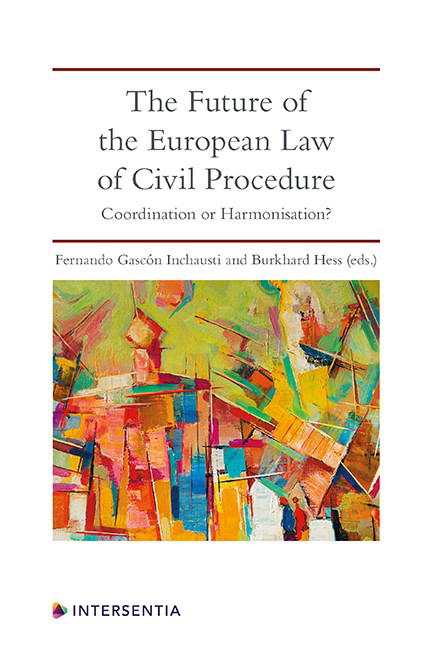Book contents
- Frontmatter
- Contents
- List of Cases
- List of Authors
- Introduction
- PART I METHODOLOGICAL APPROACHES
- PART II THE CURRENT SITUATION: VERTICAL AND HORIZONTAL HARMONISATION
- PART III CURRENT INITIATIVES FOR FURTHER HARMONISATION: The ELI/UNIDROIT Project
- The 2017 Directive Proposal on Common Minimum Standards of Civil Procedure
- Index
- ABOUT THE EDITORS
Harmonisation of the Rules on Judgments and Appeals in Europe: A Few Remarks from the Inside
Published online by Cambridge University Press: 23 July 2020
- Frontmatter
- Contents
- List of Cases
- List of Authors
- Introduction
- PART I METHODOLOGICAL APPROACHES
- PART II THE CURRENT SITUATION: VERTICAL AND HORIZONTAL HARMONISATION
- PART III CURRENT INITIATIVES FOR FURTHER HARMONISATION: The ELI/UNIDROIT Project
- The 2017 Directive Proposal on Common Minimum Standards of Civil Procedure
- Index
- ABOUT THE EDITORS
Summary
INTRODUCTION
Historically, procedural law has oft en been at the forefront when businesses or legislatures called for harmonised or uniform rules. However, our “modern“nation states have all enacted their own procedural codes, developed their own doctrinal approaches in academia and jurisprudence and, last but not least, brought about different practical habits of the legal profession. Moreover, when it comes to the realisation of substantive law in the courts, everything is interconnected. As a result, harmonising procedural law in the twentieth and twenty-first century is – despite all the literature about harmonisation at least on a European level or among Civil Law Countries – a thorny issue if one tries to show respect for, and take inspiration from, what exists on a national level. This is also true for two areas which, at first glance, may seem less difficult: judgments and appeals. The following pages aim at providing a very rough and incomplete overview of issues which have proven sensitive in the Working Groups“Judgments“and“Appeals“of the ELI/UNIDROIT Project ” From Transnational Principles to European Rules“ .
TERMINOLOGY AND PRECONCEPTIONS
GENERAL REMARKS
Whoever draft s a rule must use words. The basic rule follows the structure “if A then B“. A and B may be words pointing directly to something fixed in the tangible world: If the light is red, then you have to stop. This is an easy rule, as it refers directly to a visible condition and tells the addressee what to do. A and B may also be words which do not point to something fixed in the tangible world, but to a process: If the light turns red when you are so close that you cannot stop any more, you may pass. This rule points not to something fixed, but includes a movement or, in other words, a temporal aspect. A and B may also be words which do not point directly to something in the tangible world, but to a concept: If the light is red but there is an emergency, you need not stop. Here, the concept is the emergency. What an emergency is cannot be determined only by using one of the five senses.
- Type
- Chapter
- Information
- The Future of the European Law of Civil ProcedureCoordination or Harmonisation?, pp. 223 - 238Publisher: IntersentiaPrint publication year: 2020



